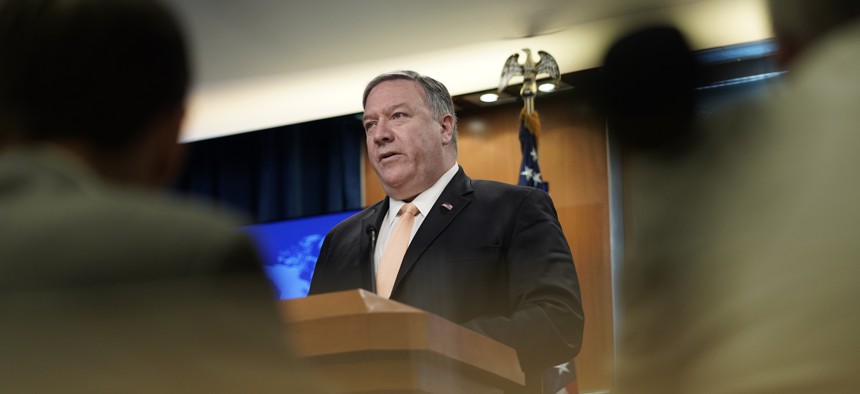
Secretary of State Mike Pompeo speaks during a news conference on Monday, April 22, 2019, at the Department of State in Washington. AP Photo/Sait Serkan Gurbuz
A Boom Time for US Sanctions
The explosive growth in their use has prompted questions about how much is too much.
The United States, as of this writing, has 7,967 sanctions in place.
Treasury Department data them in many sizes. There are sanctions on individual people, like the Mexican drug kingpin Joaquín “El Chapo” Guzman; on companies, like Cubacancun Cigars and Gift Shops; and even on entire governments or their branches, like on Iran and its main security force, the Islamic Revolutionary Guard Corps.
There may even be sanctions ahead for some U.S. allies, who are facing a deadline to stop importing Iranian oil or get hit in the administration’s economic-pressure campaign against the Islamic Republic.
American policymakers have reached for the tool almost since the embargo of 1962. Sanctions are appealing as a cudgel sharper than talking but gentler than military action. They’re for when you want to influence people, not by beating them up, but by threatening their cash flow. The use of sanctions has exploded in the 21st century, especially as the U.S. has gotten very good at tailoring financial penalties to affect individuals rather than entire countries. But while they’ve undoubtedly made it difficult for America’s enemies to make, move, or access money, some experts worry that overuse of sanctions brings long-term risks both for America’s financially dominant role in the world and its leading status in international diplomacy.
Related: Despite Threatening It, Trump Is Keeping the Military Out of Venezuela
Related: Here’s How Iran Will Try to Evade US Sanctions
Related: Trump’s Strange Tweet May Have Kept Nuclear Talks Alive
The strength of American sanctions, after all, comes from the centrality of the United States financial system in the global economy, and the dollar’s status as the world’s dominant reserve currency. “Even a company that has basically no trade in the United States, their banks do,” says Jarrett Blanc, a senior fellow in the Geoeconomics and Strategy Program at the Carnegie Endowment for International Peace. “And so they basically can’t be banked if they are trading with a country that has been targeted with these very powerful U.S. sanctions.”
One risk, Blanc says, is that the many banks of the world that “have run their financial plumbing through New York” could, if enough of them decide they can’t rely on the United States, try to run their plumbing elsewhere. “And all of a sudden the power of our sanctions is dramatically reduced,” he says.
At the same time, American willingness to use sanctions unilaterally has irritated some U.S. allies in Europe, who have participated in some U.S. sanctions efforts but objected to sanctions they see as threatening their own economic interests—such as certain restrictions on doing business with Russia and Iran. The dynamic highlights a risk of sanctions that goes beyond their economic impact and strains relations with long-standing partners.
After 9/11, the U.S. accelerated and expanded its use of sanctions to go after terrorist financing; President George W. Bush took a first step in the weeks immediately after the attacks, with an executive order freezing any U.S.-based assets of a range of groups and people, including Osama bin Laden and al-Qaeda.
“Using financial power and suasion to affect America’s enemies and their budgets—well beyond U.S. borders—provided a form of asymmetric power that the United States could use against non-state networks exploiting the global system,” Juan Zarate, who worked on counterterrorist-financing efforts in the Bush administration, recalled in recent testimony to Congress.
The use of sanctions really picked up around 2010, according to Elizabeth Rosenberg, a former Treasury Department official now at the Center for a New American Security. At that point, Barack Obama’s administration was putting its own pressure on Iran.
“This is a policy instrument of choice,” Rosenberg says. “It feels really muscular. We do not have an institutional culture of evaluating economic costs to ourselves, which makes people believe, I think mistakenly, that it is costless.” Back in 2014, my now-colleague Annie Lowrey reported for The New York Timesthat the U.S. had some 6,000 sanctions in place.
Now it has almost 2,000 more than that. The Obama administration had lifted hundreds of sanctions on Iranian people and entities after striking the nuclear deal with the Islamic Republic in 2015. Donald Trump’s administration, after getting out of the deal, reinstituted many sanctions and has steadily added more—imposing 700 on a single day last November. Iran is currently by far the largest state target of U.S. sanctions.
The administration is set to expand the financial pressure on Iran still further, having threatened to sanction anyone still importing Iranian oil after May 2.
Not all sanctions are created equal. A sanction on one person, or one aircraft, won’t have the same economic impact as sanctions on a country’s central bank. “It can be misleading to look at the number of designations and infer from that intensity or utility or effectiveness,” Rosenberg says. “One particular designation may have had a major effect and caught the attention of the world, and literally hundreds of others were a yawn, and no one really reported or paid attention and they don’t have much of an economic effect, if any at all.”
For example, hundreds of Iranian sea vessels and aircraft have been designated for sanctions, just by virtue of being Iranian-owned. “That’s quite different than an individual designation package for a specific cartel head, who’s ordered hits on the lives of hundreds of people and engaged in … weapons trafficking and narcotrafficking and human smuggling,” Rosenberg says.
The Treasury Department’s position is that, even as the number of sanctions have increased, their success is measured not by volume but by their impact in achieving specific policy goals.
On that score, sanctions have notched some successes. They may have helped drive the North Koreans to negotiate with Trump over their nuclear program, though so far no deal has resulted. Sanctions also helped push Iran to the table over its own nuclear program during the Obama administration; the Trump administration says that the current sanctions are part of an effort to push it back for a better deal.
The goals spelled out in Secretary of State Mike Pompeo’s 12 demands on Iran—including renouncing nuclear weapons, ceasing support for proxies like Hezbollah that the U.S. considers terrorist organizations, and releasing U.S. citizens imprisoned in the country—would amount to a wholesale overhaul of the country’s current foreign policy. Iranian leaders have in the past indicated that they’re not interested in negotiating over those points, though Foreign Minister Javad Zarif recently floated the idea of a prisoner exchange in a possible sign of softening. The demands have been criticized as unreachable, but Pompeo has said they amount to nothing more than a request for normal behavior of the kind the U.S. should expect from any other country.
In the meantime, though, Iran’s economy is tanking, and the country is struggling to trade on its economic lifeblood, which is oil. Whatever the long-term policy goals, and whatever the risks of pursuing them so aggressively, in the short term the administration is satisfied with the results so far.




